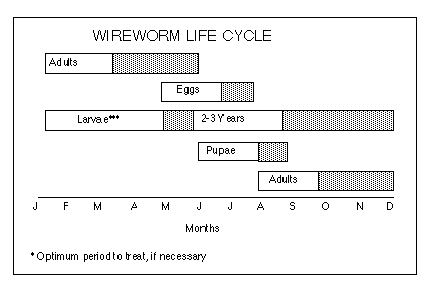LIFE CYCLE AND HABITS OF WIREWORMS
Wireworms such as Ctenicera species and Limonus species. Adult
wireworms, which are commonly called click beetles, do not generally cause
economic damage on established mint in the Pacific Northwest, but larvae can
be found feeding on mint roots, rhizomes, and stems at the soil surface.
Serious infestations occasionally occur on first year mint following potatoes,
onions, sugarbeets, grass seed, or mint planted in newly recovered land after
fallow. The most common species encountered in mint include the Pacific
Coast wireworm, Limonus canus, the sugarbeet wireworm, L. californicus, and
the Great Basin wireworm, Ctenicera pruinina.
The adult beetles are slender, tan to nearly black, and range from 1/2 to 3/4 inch
long. Larvae are hard, segmented, measure 1/2 to 1 inch long, and vary from
yellow to brown. Larvae have three pairs of legs and the last abdominal body
segment is elongated and may end in a keyhole-shaped structure.
 Wireworms overwinter as larvae or as recently developed adults which do not
emerge from the soil until the following spring, usually from early May to June.
Adults migrate by flying within fields or to new fields. The females mate and
burrow into the soil to deposit eggs. Eggs are laid singly 2 to 6 inches deep in
the soil and hatch in 3 to 4 weeks. The larvae move easily through the soil in
search of food. They can feed in the soil for 2 to 5 years before pupating in July
or August. In the Northwest, most wireworms take about 3 years to complete
their life cycles.
Wireworms overwinter as larvae or as recently developed adults which do not
emerge from the soil until the following spring, usually from early May to June.
Adults migrate by flying within fields or to new fields. The females mate and
burrow into the soil to deposit eggs. Eggs are laid singly 2 to 6 inches deep in
the soil and hatch in 3 to 4 weeks. The larvae move easily through the soil in
search of food. They can feed in the soil for 2 to 5 years before pupating in July
or August. In the Northwest, most wireworms take about 3 years to complete
their life cycles.
MANAGEMENT AND CONTROL OF WIREWORMS
Wireworm populations can be estimated by taking square foot soil samples to a
depth of about 2 to 3 inches around mint plants from several different locations
in the field. Usually, wireworm larvae, if present, also will be collected at the
same time samples are taken for redbacked cutworm, strawberry root weevil,
mint root borer, and symphylans. Soil should be screened in the field or placed
in Berlese funnels to extract these pests.
No treatment threshold has been developed for wireworms on mint. Wireworms
seldom cause serious damage on established mint, but they may be
devastating to new plantings. Damage may occur if mint is to be planted in
fields with a previous history of wireworm injury or in noncrop or fallow land.
Fields that have been fallowed for several years or planted in potatoes, cereals,
or sugarbeets should be sampled before planting mint. Using mint roots free of
insects to establish new fields is of utmost importance. If mint is to be planted in
fields with a previous history of wireworm injury, growers should consider
treating the field with Dyfonate or fumigating the soil prior to planting mint. Use
Telone II or C-17 at the rates recommended on the label. Fumigation is
expensive and therefore usually used to control multiple pests. If Dyfonate is
used, do not apply Sinbar until at least 3 weeks after the Dyfonate application.
Fields with a previous history of wireworms may be fallowed and frequently
cultivated to kill weed hosts for 1 year prior to planting mint, but, since
wireworms may take up to 3 years to complete development, some wireworm
larvae may remain in the field even after 1 year of fallow.
 Wireworms overwinter as larvae or as recently developed adults which do not
emerge from the soil until the following spring, usually from early May to June.
Adults migrate by flying within fields or to new fields. The females mate and
burrow into the soil to deposit eggs. Eggs are laid singly 2 to 6 inches deep in
the soil and hatch in 3 to 4 weeks. The larvae move easily through the soil in
search of food. They can feed in the soil for 2 to 5 years before pupating in July
or August. In the Northwest, most wireworms take about 3 years to complete
their life cycles.
Wireworms overwinter as larvae or as recently developed adults which do not
emerge from the soil until the following spring, usually from early May to June.
Adults migrate by flying within fields or to new fields. The females mate and
burrow into the soil to deposit eggs. Eggs are laid singly 2 to 6 inches deep in
the soil and hatch in 3 to 4 weeks. The larvae move easily through the soil in
search of food. They can feed in the soil for 2 to 5 years before pupating in July
or August. In the Northwest, most wireworms take about 3 years to complete
their life cycles.